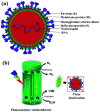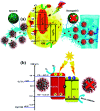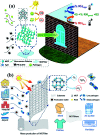Green aspects of photocatalysts during corona pandemic: a promising role for the deactivation of COVID-19 virus
- PMID: 35530385
- PMCID: PMC9073611
- DOI: 10.1039/d1ra08981a
Green aspects of photocatalysts during corona pandemic: a promising role for the deactivation of COVID-19 virus
Abstract
The selection of a facile, eco-friendly, and effective methodology is the need of the hour for efficient curing of the COVID-19 virus in air, water, and many food products. Recently, semiconductor-based photocatalytic methodologies have provided promising, green, and sustainable approaches to battle against viral activation via the oxidative capabilities of various photocatalysts with excellent performance under moderate conditions and negligible by-products generation as well. Considering this, recent advances in photocatalysis for combating the spread of the severe acute respiratory syndrome coronavirus 2 (SARS-CoV-2) are inclusively highlighted. Starting from the origin to the introduction of the coronavirus, the significant potential of photocatalysis against viral prevention and -disinfection is discussed thoroughly. Various photocatalytic material-based systems including metal-oxides, metal-free and advanced 2D materials (MXenes, MOFs and COFs) are systematically examined to understand the mechanistic insights of virus-disinfection in the human body to fight against COVID-19 disease. Also, a roadmap toward sustainable solutions for ongoing COVID-19 contagion is also presented. Finally, the challenges in this field and future perspectives are comprehensively discussed involving the bottlenecks of current photocatalytic systems along with potential recommendations to deal with upcoming pandemic situations in the future.
This journal is © The Royal Society of Chemistry.
Conflict of interest statement
There are no conflicts to declare.
Figures










Similar articles
-
A review on the potential of photocatalysis in combatting SARS-CoV-2 in wastewater.J Water Process Eng. 2021 Aug;42:102111. doi: 10.1016/j.jwpe.2021.102111. Epub 2021 Apr 30. J Water Process Eng. 2021. PMID: 35592059 Free PMC article.
-
Photocatalysis air purification systems for coronavirus removal: Current technologies and future trends.Chemosphere. 2024 Apr;353:141525. doi: 10.1016/j.chemosphere.2024.141525. Epub 2024 Feb 21. Chemosphere. 2024. PMID: 38395369 Review.
-
Current perspective in metal oxide based photocatalysts for virus disinfection: A review.J Environ Manage. 2022 Apr 15;308:114617. doi: 10.1016/j.jenvman.2022.114617. Epub 2022 Feb 1. J Environ Manage. 2022. PMID: 35121465 Free PMC article. Review.
-
The practicality and prospects for disinfection control by photocatalysis during and post-pandemic: A critical review.Environ Res. 2022 Jun;209:112814. doi: 10.1016/j.envres.2022.112814. Epub 2022 Jan 26. Environ Res. 2022. PMID: 35090874 Free PMC article. Review.
-
Advanced photocatalytic materials based degradation of micropollutants and their use in hydrogen production - a review.RSC Adv. 2024 May 2;14(20):14392-14424. doi: 10.1039/d4ra01307g. eCollection 2024 Apr 25. RSC Adv. 2024. PMID: 38699688 Free PMC article. Review.
Cited by
-
A critical review on the existing wastewater treatment methods in the COVID-19 era: What is the potential of advanced oxidation processes in combatting viral especially SARS-CoV-2?J Water Process Eng. 2022 Oct;49:103077. doi: 10.1016/j.jwpe.2022.103077. Epub 2022 Aug 17. J Water Process Eng. 2022. PMID: 35990175 Free PMC article. Review.
-
Perspectives for Photocatalytic Decomposition of Environmental Pollutants on Photoactive Particles of Soil Minerals.Materials (Basel). 2024 Aug 9;17(16):3975. doi: 10.3390/ma17163975. Materials (Basel). 2024. PMID: 39203153 Free PMC article. Review.
-
Light-Induced Transformation of Virus-Like Particles on TiO2.ACS Appl Mater Interfaces. 2024 Jul 17;16(28):37275-37287. doi: 10.1021/acsami.4c07151. Epub 2024 Jul 3. ACS Appl Mater Interfaces. 2024. PMID: 38959130 Free PMC article.
-
Self-Sanitization in a Silk Nanofibrous Network for Biodegradable PM0.3 Filters with In Situ Joule Heating.ACS Omega. 2024 Feb 15;9(8):9137-9146. doi: 10.1021/acsomega.3c08020. eCollection 2024 Feb 27. ACS Omega. 2024. PMID: 38434843 Free PMC article.
References
-
- World Health Organization, WHO Director-General’s Opening Remarks at the Mission Briefing on COVID-19, 2020
Publication types
LinkOut - more resources
Full Text Sources
Miscellaneous

